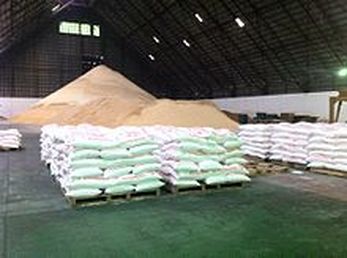 Image From: http://en.wikipedia.org/wiki/Economy_of_the_Philippines
Image From: http://en.wikipedia.org/wiki/Economy_of_the_Philippines The Republic of the Philippines is first and foremost a country that is founded on agriculture. Around two thirds of the populace makes their living through farming, and 47% of the land is abundant in agriculture. Ironically though, even if the nation is rich in natural resources and huge agricultural land, the farmers are still marginalized and poor. The Philippines had to bring in agricultural items such as rice (the staple food of the Filipino) because of minimal productivity, a population that is still growing at a fast rate, and the demolishing of major agricultural lands to make way for commercial use.
During the year 2008, the local government used a lot of its funding for rice imports, which were then sold at cheap prices. While this cost the consolidator in the Philippines and the government a lot of money, they did this to prevent widespread panic amongst the citizens. Rather than doing service for the farmers, the drive of the Philippines to be economically independent via conventional farming that employed extensive and commercial agro-chemicals and inorganic fertilizers resulted in farmers who sank deeper into poverty and extreme debt.
A lot of these rice farmers have become dependent on the seed subsidies, fertilizers or price support from the local government. The problem was that some of their produce declined or stagnated because of applying all of these non-organic instruments for long durations.
A concerned group of people in PAKISAMA (Pambansang Kilusan ng mga Samahang Magsasaka) conceptualized a project that would boost the services of the organizations that the farmers were involved in, as well as their communities to guarantee collective, coordinated, and institutionalized actions for surviving the fluctuating food prices via policy dialogue, marketing, and sustainable agricultural manufacturing.
These actions would concentrate on the consolidator in the Philippines and the minor farmers who produce vital food items in the county and streamline the process so that all project activities could easily be designed and implemented.
During the year 2008, the local government used a lot of its funding for rice imports, which were then sold at cheap prices. While this cost the consolidator in the Philippines and the government a lot of money, they did this to prevent widespread panic amongst the citizens. Rather than doing service for the farmers, the drive of the Philippines to be economically independent via conventional farming that employed extensive and commercial agro-chemicals and inorganic fertilizers resulted in farmers who sank deeper into poverty and extreme debt.
A lot of these rice farmers have become dependent on the seed subsidies, fertilizers or price support from the local government. The problem was that some of their produce declined or stagnated because of applying all of these non-organic instruments for long durations.
A concerned group of people in PAKISAMA (Pambansang Kilusan ng mga Samahang Magsasaka) conceptualized a project that would boost the services of the organizations that the farmers were involved in, as well as their communities to guarantee collective, coordinated, and institutionalized actions for surviving the fluctuating food prices via policy dialogue, marketing, and sustainable agricultural manufacturing.
These actions would concentrate on the consolidator in the Philippines and the minor farmers who produce vital food items in the county and streamline the process so that all project activities could easily be designed and implemented.
 RSS Feed
RSS Feed